바이러스 뇌염과 일본 뇌염, Viral encephalitis and Japanese encephalitis
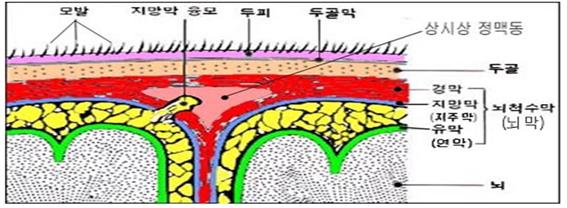
그림 2-60.두피, 두개골, 뇌막, 뇌의 그림.
뇌막에 세균이 감염되면 세균성 뇌막염이 생길 수 있다.
Copyright ⓒ 2011 John Sangwon Lee, MD, FAAP
바이러스 뇌염과 일본 뇌염의 개요
-
바이러스 감염이나 박테리아 감염 등으로 생긴 뇌 염증을 감염성 뇌염이라고 하고, 무기 화학 물질 중독, 또는 유기 화학 물질 중독으로 생긴 뇌 염증을 비 감염성 뇌염(Non-infectious encephalitis)이라고 한다.
-
뇌염의 원인은 위에서 설명한 것처럼 여러 가지가 있다.
-
뇌염이 바이러스 감염으로 생기면 바이러스 뇌염이라고 한다.
-
어떤 종류의 바이러스는 신체의 여러 계통의 기관이나 조직에 1차적 감염병을 일으키지 않고 뇌에 직접 1차적 감염병을 일으켜 바이러스 뇌염이 생길 수 있다.
-
어떤 종류의 바이러스는 신체의 어떤 계통의 기관이나 조직에도 1차로 감염되어 거기에 바이러스 감염병이 생기고 뇌에도 1차적으로 동시 감염되어 바이러스 뇌염이 1차적으로 생길 수 있다.
-
때로는 바이러스가 전 혈액에 감염되고 전신 모든 계통의 기관이나 조직에 동시 감염되어 바이레미아를 일으킬 수 있다. 마치 박테리아가 패혈증을 일으키는 것과 같이 전신성 바이러스 감염병을 일으키기도 한다.
-
어떤 종류의 바이러스는 뇌 이외 신체의 다른 계통의 한 기관이나 한 조직에 1차적으로 감염되어 거기서 바이러스 감염병을 일으킨 후 그 바이러스 감염병이 다 나은 후 바이러스 항원 항체 이상반응이 뇌에 생겨 바이러스 항원 항체 뇌염이 생길 수 있다.
-
다시 설명하면, 바이러스가 뇌에 직접 1차적으로 감염되어 뇌에 바이러스 뇌염이 생길 수도 있고, 뇌염을 일으켰던 바이러스가 다 없어진 후 뇌 항원 항체 반응으로 뇌에 병변이 생겨 그로 인해 생긴 뇌염도 있다.
-
어떤 바이러스는 뇌와 뇌막에 동시 감염되어 뇌, 뇌막 염증을 동시 일으켜 바이러스 뇌막염 및 뇌염이 동시 생기기도 한다. 이와 같이 바이러스 감염이 뇌에 생겨 여러 종류의 바이러스 뇌염 및, 또는 뇌막염이 생길 수 있다.
-
뇌염을 일으키는 바이러스의 종류에 따라 일본 뇌염, 콜로라도 진드기 열로 생긴 뇌염, 서 나일 바이러스 감염에 의한 뇌염 등 여러 종류의 뇌염이 있다.
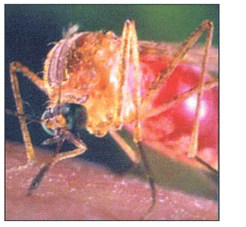
사진 4-10. 모기는 일본 뇌염, 말라리아, 서 나일강 뇌염 등을 전파시킬 수 있는 매개체이다.
출처CDC/william Brogdon
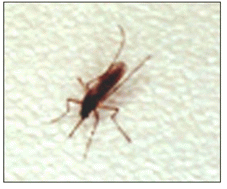
사진 4-11. 모기는 말라리아 원충, 일본 뇌염 바이러스나 서 나일강 바이러스 등을 전파할 수 있다.
Copyright ⓒ 2013 John Sangwon Lee, MD. FAAP
바이러스 뇌염과 일본 뇌염의 원인
-
이미 설명했지만, 바이러스 감염으로 뇌염이 생길 수 있지만 바이러스 감염 이외, 박테리아 감염, 묘소병, 라임병, 원충 감염, 리케치아 감염, 마이코플라스마 감염, 곰팡이(진균) 감염, 기생충 감염, 백신 과민반응, 중금속 중독, 또는 약물 중독 등으로 뇌염이 생길 수 있다.
급성 뇌염을 일으킬 수 있는 비 바이러스 원인
-
뇌농양, 결핵성 뇌염, 마이코플라스마 감염성 뇌염, 브루셀라병, 묘조병(묘소병),라임병, 매독, 색전성 박테리아 뇌염, 스피로헤타 병, 리케치아 감염, 원충 감염, 곰팡이균 감염, 기생충 감염, 백신 과민반응, 중금속 중독, 또는 약물 중독, 전신성 홍반성 낭창, 사르코이드증, 비세트병, 악성 종양성 뇌염, 악성 고혈압성 뇌염, 라이 증후군, 과암모니아증, 저혈당증, 신진대사성 질환 등
급성 바이러스 뇌염을 일으킬 수 있는 바이러스
-
홍역바이러스, 풍진바이러스, 볼거리바이러스, 수두바이러스, 1형과 2형 헤르페스바이러스, 수두– 대상포진바이러스 등의 바이러스 감염으로 뇌염이 생길 수 있다.
-
사이토메갈로 바이러스 뇌 감염, 전염성 단핵구증 뇌 감염, 엔테로바이러스 뇌 감염, 아데노 바이러스 뇌 감염, 콕삭키바이러스 뇌 감염, 에코바이러스 뇌 감염, 폴리오바이러스 뇌 감염, 일본 뇌염 바이러스 뇌 감염, 아데노바이러스 뇌 감염, 파라 인플루엔자바이러스 뇌 감염, 인플루엔자바이러스 뇌염, 광견병바이러스 뇌 감염, 아르보바이러스 뇌 감염 등으로 바이러스 뇌염이 생길 수 있다.
-
캘리포니아 뇌염, 캘리포니아 진드기 열, 북미서부말 뇌염, 사람 면역결핍 바이러스 뇌염, 북미동부말 뇌염, 세인트루이스 뇌염 등
-
미국에서는 헤르페스바이러스 뇌염(헐퍼스바이러스 뇌염)은 전체 바이러스 뇌염의 10% 차지한다.
-
그 외 바이러스 뇌염을 일으키는 감염 경로는 바이러스 뇌염을 일으킨 바이러스의 종류에 따라 다르다.
-
예를 들면, 엔테로바이러스(장 바이러스)는 불결한 손, 음식물, 또는 음료수 등을 통해서 감염될 수 있고 잠복기는 약 6일이고
-
홍역바이러스는 기침을 할 때 생기는 비말 등으로 감염될 수 있으며,
-
일본 뇌염바이러스를 보균한 모기에 물려 일본 뇌염바이러스에 감염될 수 있다.
-
엔테로바이러스 위장염이 많이 유행되는 여름철에는 엔테로바이러스 감염으로 뇌염이 발생될 수 있고,
-
일본 뇌염바이러스를 보균한 모기가 많은 해 여름철에 일본 뇌염이 더 많이 발생될 수 있다.
-
소, 말, 새 등 여러 종류의 척추동물과 조류 등이 일본 뇌염바이러스를 보균할 수 있다. 이런 척추동물이나 조류가 많이 서식하는 지역이나 나라에서 일본 뇌염이 더 많이 발생될 수 있다.
-
일본 뇌염을 앓고 있는 환자 자신이 다른 사람들에게 일본 뇌염바이러스를 직접 감염시키지는 않는다.
-
아르보바이러스(Arbovirus)에 감염된 새들이나 포유동물을 문 모기, 진드기, 모래 파리 등 절족동물이나 곤충이 아르보바이러스를 보균한다. 그런 곤충 등이 사람을 물을 때 아르보바이러스에 사람이 감염되고 그로 인해 아르보바이러스 뇌염이 생길 수 있다.
-
일본 뇌염, 동부 말 뇌염, 서부 말 뇌염, 서나일 뇌염, 세인트 루스 뇌염, 베네주엘라 말 뇌염, 포와싼 뇌염, 캘리포니아 뇌염은 대표적인 아르보바이러스 뇌염이다. 다음은 일본 뇌염에 관해서 주로 설명한다.
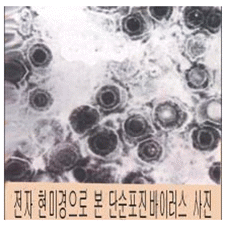
사진 4-12. 헤르페스바이러스 사진
출처–미 CDC 49
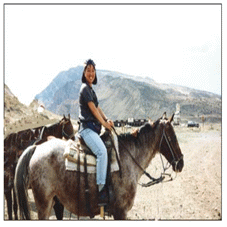
사진 4-13. 말이 뇌염바이러스를 보균할 수 있다.
Copyright ⓒ 2013 John Sangwon Lee, MD. FAAP
바이러스 뇌염의 일반적 증상 징후
-
바이러스 뇌염의 증상 징후는 원인, 정도, 합병증의 유무 등에 따라 다르다.
-
아주 경미한 바이러스 뇌염에 걸렸을 때는 뇌염에 걸려 있는지 모를 정도로 증상 징후가 경미하게 나타나고, 미열이 나고 얼마 후 자연히 완치되기도 한다.
-
아주 심한 뇌염에 걸리면 중추신경 감염–뇌염, 무균 뇌막염, 척수염 등으로 인한 증상 징후가 나타날 수 있고 원인불명의 열 및, 또는 피부 발진, 급성 다 관절염, 출혈열 등 4 주증이 나타나는 것이 보통이다.
-
일본 뇌염에 심하게 걸리면 인두통, 결막염, 피로, 소화 장애, 구토, 흥분, 정신착란, 행동장애, 정신이상, 소재식 불명, 계속 수면, 손발 떨림, 경련, 근육경직, 또는 근육이완이 생기면서 전신경련, 대소변 싸기, 혼수상태, 귈랑–바레 증후군 등이 생길 수 있다.
-
이런 증상 징후가 며칠 내지 몇 주 동안 계속될 수 있다.
-
그러나 대부분의 일본 뇌염 바이러스에 감염된 후 불현성 감염이 생겨 아무 증상 징후가 나타나지 않을 수 있다.
-
급성 일본 뇌염에 걸린 일부는 완전히 회복될 수 있고, 일부는 만성 뇌염으로 진전된다.
-
일본 뇌염을 앓는 환아들의 40∼70%는 사망한다.
바이러스 뇌염의 진단
-
바이러스 뇌염의 원인 따라 진단 방법이 다르다.
-
일반적으로, 병력·증상 징후·진찰소견 등을 종합하여 바이러스 뇌염이 의심되면 피 검사, 대소변 검사, 뇌척수 액 검사, 혈청검사, 뇌파검사, 뇌 CT 스캔 검사, 뇌 MRI 검사, 두부 X선 사진 검사 등으로 진단할 수 있다.
-
특히 뇌척수 액으로 PCR 검사 등은 진단하는데 도움이 된다.
-
인두 점액, 피, 변, 뇌척수 액 등으로 바이러스 배양검사를 해서 확진할 수 있다.
-
일본 뇌염이 유행되는 지방에서 모기에 물린 후 뇌염의 증상 징후가 생기면 일본 뇌염을 진단하는 데 도움이 된다.
-
일본 뇌염바이러스를 보균한 모기에 물린 후 1주 정도 지나면 일본 뇌염이 발생할 수 있다.
-
중금속 중독·농약 중독·독극물 중독, 뇌 종양, 뇌 농양, 약물 중독, 박테리아 뇌막염 등으로 생긴 증상 징후가 일본 뇌염이나 다른 종류의 바이러스 뇌염으로 생긴 증상 징후와 비슷할 수 있다. 이런 병과 일본 뇌염과 일본 뇌염 이 외의 바이러스 뇌염과 감별 진단해야 한다.
바이러스 뇌염의 치료
-
헤르페스바이러스 뇌염은 에이사이클로비아 등 항 바이러스제로 치료될 수 있다.
-
그 외 거의 대부분의 바이러스 뇌염은 항 바이러스제로 잘 치료되지 않는다.
-
따라서 일본 뇌염도 대증 치료를 한다.
-
열이 나고 아프면 타이레놀 등 해열 진통제로 해열 진통시킨다.
-
고열이 나면 특수 고열치료 담요 등으로 치료할 수 있다.
-
탈수를 포도당 전해질용액 혈관주사로 재수화 치료 하고 현상 유지 수화 치료 한다.
-
페노바르비탈이나 바리움(Valium) 등 항 경련 약으로 전신 경련을 예방하고 치료 한다.
-
비정상적으로 높은 뇌압은 만니톨(Mannitol) 등으로 치료하고 호흡곤란은 산소호흡으로 치료한다.
-
연하 근육마비로 음식물을 씹고 넘길 수 없을 때는 급식관(비위 또는 구위 피딩 튜브)을 입이나 콧구멍을 통하여 위 속에 넣고 그 관을 통해 영양분 공급을 하든지 혈관주사로 영양분 공급한다.
-
홍역바이러스 뇌염·풍진 바이러스 뇌염·일본 뇌염 등은 예방접종 백신으로 예방한다.
일본 뇌염 백신 예방접종 Japanese encephalitis vaccine immunization
-
[부모도 반의사가 되어야 한다–소아가정간호백과]-제2권 소아청소년 질병 및 안전사고 예방 참조.
-
불활성 일본 뇌염 백신(J-Vax. Japanese Encephalitis virus vaccine inactive)으로 일본 뇌염을 예방접종한다.
-
전 세계 모든 아이들이 일본 뇌염 백신을 기본적으로 접종받으라고 권장하지 않는다.
-
그러나 일본 뇌염이 많이 유행되는 나라에서 사는 아이들은 일본 뇌염 백신을 기본적으로 접종받는다.
-
일본 뇌염 발생률이 많은 지역이나 나라에 30일 이상 더 오레 동안 여행가는 사람들은 일본 뇌염 백신으로 여행을 떠가기 전에 접종받을 것을 권장한다.
-
예방접종을 받은 후 면역 효과와 예방접종으로 생기는 부작용, 그 지역에 여행가 있는 기간, 모기가 얼마나 기승하는지, 일본뇌염이 얼마나 유행되는지 등에 따라 일본 뇌염 예방접종을 의사의 지시 하에 접종받아야 한다. 더 자세한 정보는; www.cdc.gov/travel
일본 뇌염 백신 예방접종의 연령과 예방접종 방법
-
1~3세 유아는 일본 뇌염 백신 J-Vax 0.5cc으로 1차로 접종받고, 1차 접종받은 후 제 7일에 2차, 그리고 제 30일에 3차 접종 받아서 총 3차 접종받는다.
-
3세나 3세 이후 유아들은 일본 뇌염 백신 J-Vax 1.0cc로 1차 접종 받고 그후, 제 7일에 2차, 제 30일에 3차 접종 받아 총 3차 접종받는다.
-
또는 첫날에 1차, 제 7일에 2차 그리고 제 30일에 3차 접종받는 대신, 첫날에 1차, 제 7일에 2차, 그리고 제 14일에 3차 접종 받아 총 3차 접종받는 방법도 있다.
-
1세 이하 영아들에게는 일본 뇌염 예방접종을 권장하지 않는다.
-
이상 권장한 예방접종 스케줄에 따라 첫 예방접종 배열을 끝마친 2년 후에 추가 예방접종을 받을 수 있다.
-
3세 이상의 유아는 J-Vax 백신 1.0cc로, 1~3세 소아에게는 J-Vax 백신 0.5cc로 추가 접종을 받을 수 있다.
-
건강검진을 받고 열이 나는지 알아보기 위해 체온을 잰다.
-
발열성 질환이 없고 예방접종 백신에 알레르기가 없고 접종 금기 사항이 없으면 예방접종을 받을 수 있다.
일본 뇌염 백신 예방접종의 부작용
-
접종 받은 국소가 조금 아프고, 붓고, 발적될 수 있고, 두통, 열, 두드러기, 근육통, 발진, 알레르기 등의 부작용이 생길 수 있다.
일본 뇌염 백신 예방접종의 금기
-
예방접종 백신이나 접종백신 성분에 알레르기가 있는 사람은 접종을 받아서는 안 된다.
|
다음은 “일본뇌염 백신 예방접종”에 관한 인터넷 소아청소년 건강상담 질의응답의 예 입니다. |
Q.&A. 일본뇌염 백신 예방접종
Q.
번번이 찾아와 좋은 정보 많이 가져갑니다.
두 아이의 뇌염 예방접종을 해야 하나요, 작년 했거던요. 3살과 5살입니다.
무더운 여름 시원하게 보내세요, 감사합니다.
A.
숙자님
안녕하세요. 질문해 주셔 감사합니다.
자녀의 나이, 성별, 과거와 가족의 병력, 진찰소견, 임상검사 결과 등 많은 정보가 있으면 더 좋은 답변을 드릴 수 있습니다. 주신 정보를 참작해 답변을 드립니다.
컴퓨터상의 문제 등으로 답변이 늦어 죄송합니다.
일본 뇌염 예방접종 정보에서 참조하시기 바랍니다.
“1~3세 유아는 접종 첫 날 J-Vax 백신 0.5cc를, 첫 접종을 받은 후 제 7일, 그리고 제 30일에 각각 1회 접종받아서 총 3차 접종받는다.
3세나 그 이상 소아는 J-Vax 백신 1.0cc를 첫 날, 첫 접종 받은 후 제 7일 그리고 제 30일에 1회 접종해서 총 3차 접종받을 수 있고 첫날, 제 7일 그리고 제 30일에 접종받는 대신 첫날, 제 7일 그리고 제 14일에 1회 접종받아서 총 3차 접종 받을 수 있다.
1세 이하 영아들에게는 접종하지 않는다.
이상 권장한 예방접종 스케줄에 따라 첫 예방접종을 받은 2년 후에 추가 예방접종을 할 수 있다. 3세 이상의 유아들에게는 J-Va 백신 1.0cc로, 1-3세 유아에게는 J-Vax 백신 0.5cc로 추가 접종 할 수 있다.”
미 소아청소년 학회의 권장에 따르면 3차 예방접종 배열을 끝마친 후 2년 후에 추가로 접종하라고 권장합니다.
따라서 미 소아청소년 학회의 권장에 따르면 금년도에는 일본뇌염 예방접종을 해줄 필요가 없습니다. 그로나 각 나라 소아 예방접종 정책에 따라 예방접종 백신과 접종 방법이 다를 수 있기 때문에 소아청소년에서 상담해서 결정하시기 바랍니다. 질문이 더 있으시면 다시 연락 주세요. 감사합니다. 이상원 드림
Viral encephalitis and Japanese encephalitis

Figure 2-60. Illustration of the scalp, skull, meninges, and brain. Bacterial infection of the meninges can cause bacterial meningitis. Copyright ⓒ 2011 John Sangwon Lee, MD, FAAP Overview of Viral Encephalitis and Japanese Encephalitis
• Brain inflammation caused by viral or bacterial infection is called infectious encephalitis, and brain inflammation caused by inorganic chemical poisoning or organic chemical poisoning is called non-infectious encephalitis.
• There are several causes of encephalitis, as described above.
• When encephalitis is caused by a viral infection, it is called viral encephalitis.
• Some types of virus can cause viral encephalitis by directly causing primary infectious diseases in the brain without causing primary infectious diseases in various organs or tissues of the body.
• A certain kind of virus can primarily infect organs or tissues of any system in the body, causing a viral infection, and primary co-infection in the brain, resulting in primary viral encephalitis.
• Sometimes the virus can infect whole blood and co-infect organs or tissues of all systems, causing viremia. Just as bacteria cause sepsis, so can systemic viral infections.
• A certain kind of virus first infects one organ or tissue in other body systems other than the brain and causes a viral infection there. this can happen
• In other words, viral encephalitis may occur in the brain due to direct primary infection of the virus with the brain, and there is encephalitis caused by lesions in the brain due to a brain antigen-antibody reaction after the virus that caused encephalitis is completely eliminated.
• Some viruses simultaneously infect the brain and meninges, causing inflammation of the brain and meninges at the same time, causing viral meningitis and encephalitis. As such, a viral infection in the brain can result in several types of viral encephalitis and/or meningitis.
• Depending on the type of virus that causes encephalitis, there are several types of encephalitis, including Japanese encephalitis, encephalitis caused by Colorado tick fever, and encephalitis caused by West Nile virus infection.

Photo 4-10. Mosquitoes are carriers that can transmit Japanese encephalitis, malaria, and West Nile encephalitis. SourceCDC/William Brogdon

Photo 4-11. Mosquitoes can transmit the malaria parasite, Japanese encephalitis virus, and West Nile virus. Copyright ⓒ 2013 John Sangwon Lee, MD. FAAP
Causes of viral encephalitis and Japanese encephalitis
• As already explained, viral infections can cause encephalitis, but other than viral infections, bacterial infections, graveyard disease, Lyme disease, protozoal infections, rickettsia infections, mycoplasma infections, fungal (fungal) infections, parasitic infections, vaccine hypersensitivity reactions, heavy metals Encephalitis can occur due to poisoning or drug addiction. Non-viral causes that can cause acute encephalitis
• Brain abscess, tuberculous encephalitis, mycoplasma-infectious encephalitis, brucellosis, catnip disease, Lyme disease, syphilis, embolic bacterial encephalitis, spirochete disease, rickettsia infection, protozoan infection, fungal infection, parasitic infection, vaccine hypersensitivity reaction , heavy metal poisoning, or drug addiction, systemic lupus erythematosus, sarcoidosis, Biset’s disease, malignant neoplastic encephalitis, malignant hypertensive encephalitis, Reye’s syndrome, hyperammonemia, hypoglycemia, metabolic disease, etc. Viruses that can cause acute viral encephalitis
• Encephalitis can be caused by viral infections such as measles virus, rubella virus, mumps virus, varicella virus, herpes types 1 and 2, and varicella-zoster virus.
• Cytomegalovirus brain infection, infectious mononucleosis brain infection, enterovirus brain infection, adenovirus brain infection, coxsackievirus brain infection, echovirus brain infection, poliovirus brain infection, Japanese encephalitis virus brain infection, adenovirus brain infection, para Influenza virus brain infection, influenza virus encephalitis, rabies virus brain infection, and arbovirus brain infection can cause viral encephalitis.
• California encephalitis, California tick fever, North American equine encephalitis, human immunodeficiency virus encephalitis, North American equine encephalitis, St. Louis encephalitis, etc.
• In the United States, herpesvirus encephalitis (herpesvirus encephalitis) accounts for 10% of all viral encephalitis.
• Other routes of infection that cause viral encephalitis depend on the type of virus that caused viral encephalitis.
• For example, enteroviruses (enteroviruses) can be transmitted through unclean hands, food, or drink and have an incubation period of about 6 days.
• Measles virus can be transmitted through droplets produced when coughing,
• You can become infected with the Japanese encephalitis virus by being bitten by a mosquito carrying the Japanese encephalitis virus.
• In summer, when enterovirus gastroenteritis is prevalent, encephalitis can occur due to enterovirus infection,
• Japanese encephalitis may occur more in summer when mosquitoes carrying the Japanese encephalitis virus are high.
• Several types of vertebrates and birds, such as cattle, horses, and birds, can carry the Japanese encephalitis virus. Japanese encephalitis is more likely to occur in regions or countries where these vertebrates and birds are abundant.
• Patients with Japanese encephalitis do not directly transmit the Japanese encephalitis virus to others.
• Arthropods and insects such as mosquitoes, ticks, and sandflies that bite birds or mammals infected with Arbovirus carry arbovirus. When such insects and others bite humans, humans can become infected with arbovirus, which can cause arbovirus encephalitis.
• Japanese encephalitis, eastern equine encephalitis, western equine encephalitis, Western Nile encephalitis, St. Louis encephalitis, Venezuelan equine encephalitis, Poisan encephalitis, and California encephalitis are typical arbovirus encephalitis. The following mainly describes Japanese encephalitis.

Photo 4-12. herpes virus pictures Source – US CDC 49

Photo 4-13. Horses can carry encephalitis virus. Copyright ⓒ 2013 John Sangwon Lee, MD. FAAP
Common Symptoms of Viral Encephalitis
• Symptoms of viral encephalitis vary depending on the cause, severity, and presence or absence of complications.
• When you have a very mild viral encephalitis, the symptoms are so mild that you don’t even know you have encephalitis, and after a while, you have a slight fever, and then you are completely cured.
• In very severe encephalitis, symptoms and signs due to central nervous system infection-encephalitis, aseptic meningitis, myelitis, etc. may appear, and 4 weeks of symptoms such as fever of unknown cause and/or skin rash, acute polyarthritis, and hemorrhagic fever are common.
• Severe Japanese encephalitis causes sore throat, conjunctivitis, fatigue, digestive disorders, vomiting, excitement, delirium, behavioral disorder, insanity, unknown whereabouts, continued sleep, tremors, convulsions, muscle stiffness, or muscle relaxation. Convulsions, urination, coma, and Guillain-Barré syndrome may occur.
• These symptoms may last for several days or weeks.
• However, a subclinical infection may occur after infection with most Japanese encephalitis viruses and no symptoms may appear.
• Some people with acute Japanese encephalitis can fully recover, and some progress to chronic encephalitis.
• 40-70% of children with Japanese encephalitis die.
Diagnosis of viral encephalitis
• Diagnosis methods differ depending on the cause of viral encephalitis.
• In general, if viral encephalitis is suspected by combining the medical history, symptom signs, and examination findings, blood tests, urine tests, cerebrospinal fluid tests, serological tests, EEG tests, brain CT scan tests, brain MRI scans, and head X-ray examinations can be diagnosed, etc.
• In particular, PCR tests with cerebrospinal fluid are helpful for diagnosis.
• It can be confirmed by performing a virus culture test with pharyngeal mucus, blood, feces, or cerebrospinal fluid.
• In areas where Japanese encephalitis is endemic, symptomatic signs of encephalitis after a mosquito bite can help diagnose Japanese encephalitis.
• Japanese encephalitis can occur about a week after being bitten by a mosquito carrying the Japanese encephalitis virus.
Symptoms caused by heavy metal poisoning, pesticide poisoning, poison poisoning, brain tumors, brain abscesses, drug poisoning, bacterial meningitis, etc. may be similar to those caused by Japanese encephalitis or other types of viral encephalitis. These diseases should be differentiated from Japanese encephalitis and viral encephalitis other than Japanese encephalitis.
Treatment of viral encephalitis
• Herpesvirus encephalitis can be treated with antiviral drugs such as acyclovir.
• Most other viral encephalitis is not treated well with antiviral drugs.
• Therefore, Japanese encephalitis is treated symptomatically.
• If you have a fever and are sick, use an antipyretic analgesic such as Tylenol to relieve fever.
• If you have a high fever, you can treat it with a special hyperthermia blanket.
• Treatment of dehydration by intravascular injection of glucose electrolyte solution and maintenance of the status quo.
• Prevent and treat generalized convulsions with anticonvulsants such as phenobarbital or Valium.
• Abnormally high intracranial pressure is treated with mannitol, etc., and dyspnea is treated with oxygen respiration.
• When it is impossible to chew and pass food due to paralysis of swallowing muscle, insert a feeding tube (nasogastric or oral feeding tube) into the stomach through the mouth or nostrils and supply nutrients through the tube or by intravenous injection.
• Measles virus encephalitis, rubella virus encephalitis, and Japanese encephalitis are prevented by vaccination.
Japanese encephalitis vaccine immunization
• [Parents should also become at least the half-doctors – Encyclopedia of Pediatric and Family Nursing] – See Volume 2 Prevention of Diseases and Accidents in Children and Adolescents.
• Vaccinate against Japanese encephalitis with J-Vax.
Japanese Encephalitis virus vaccine inactive.
• We do not recommend that all children in the world receive the Japanese encephalitis vaccine as a primary vaccine.
• However, children living in countries where Japanese encephalitis is prevalent are usually vaccinated against Japanese encephalitis.
• It is recommended that people traveling to regions or countries with a high incidence of Japanese encephalitis for more than 30 days get vaccinated with the Japanese encephalitis vaccine before traveling.
• The Japanese encephalitis vaccination should be administered under the direction of a doctor, depending on the immunity effect after vaccination, side effects caused by vaccination, the length of travel in the area, the prevalence of mosquitoes, and the prevalence of Japanese encephalitis. For more information; www.cdc.gov/travel Age of Japanese Encephalitis Vaccination and Vaccination Method
• Infants 1 to 3 years old receive the 1st dose of Japanese Encephalitis Vaccine J-Vax 0.5cc, the 2nd dose on the 7th day, and the 3rd dose on the 30th day to receive the 3rd dose. • Infants aged 3 or older receive the 1st dose of Japanese Encephalitis Vaccine J-Vax 1.0cc, then receive the 2nd dose on the 7th day and the 3rd dose on the 30th day to receive a total of 3 doses.
• Or instead of getting the 1st dose on the first day, the 2nd dose on the 7th, and the 3rd dose on the 30th, get the 1st dose on the first day, the 2nd dose on the 7th, and the 3rd dose on the 14th for a total of 3 doses. There is a way.
• Japanese encephalitis vaccination is not recommended for infants under 1 year of age.
• According to the vaccination schedule recommended above, you can receive a booster vaccination two years after completing the first vaccination sequence.
• Children over 3 years of age can receive a booster dose of 1.0cc of J-Vax vaccine, and children 1~3 years old can receive a booster dose of 0.5cc of J-Vax vaccine.
• Get a medical examination and take your temperature to see if you have a fever.
• Vaccination is possible if there is no febrile illness, no allergy to vaccination vaccine, and no contraindications to vaccination.
Side Effects of Japanese Encephalitis Vaccination
• The inoculated area may be slightly painful, swollen, and red, and side effects such as headache, fever, hives, muscle pain, rash, and allergy may occur.
Contraindications to Japanese Encephalitis Vaccination
• People who are allergic to the vaccine or any component of the vaccine should not be vaccinated.
The following is an example of Q&A for health counseling for children and adolescents on the Internet regarding “Japanese encephalitis vaccine vaccination”.
Q&A.
Japanese Encephalitis Vaccination
Q. They come over and over again and bring a lot of good information. Do I need to vaccinate my two children for encephalitis, I did last year. They are 3 and 5 years old. Have a cool summer, thank you.
A. Mr. Sookja Hello. Thank you for asking a question. We can give you a better answer if you have a lot of information such as your child’s age, gender, past and family medical history, examination findings, and clinical test results. We will respond based on the information you have provided. Sorry for the late reply due to computer problems, etc. Please refer to Japanese Encephalitis Vaccination Information. “Infants 1 to 3 years old receive 0.5cc of J-Vax vaccine on the first day of inoculation, and 1 dose each on the 7th and 30th days after the first inoculation, for a total of 3 doses.
Children 3 years of age or older can receive a total of 3 doses of J-Vax vaccine 1.0cc on the first day, on the 7th and 30th days after the first dose. Instead of receiving the vaccine, you can receive a total of 3 doses by receiving one dose on the first, 7th, and 14th days. Do not vaccinate children under 1 year of age. According to the vaccination schedule recommended above, a booster vaccination can be given two years after the first vaccination. Infants aged 3 years and older can receive a booster dose of 1.0 cc of J-Va vaccine, and infants 1-3 years of age can receive a booster dose of 0.5 cc of J-Vax vaccine.
” According to the recommendations of the American Academy of Pediatrics and Adolescents, a booster dose should be given two years after completion of the third immunization sequence.
Therefore, according to the recommendation of the American Academy of Pediatrics, Japanese encephalitis vaccination is not required this year.
However, depending on the vaccination policy for children in each country, the vaccination vaccine and method of vaccination may be different. If you have any more questions, please contact us again. thank you. Lee Sang-won Dream
출처 및 참조 문헌 Sources and references
- NelsonTextbook of Pediatrics 22ND Ed
- The Harriet Lane Handbook 22ND Ed
- Growth and development of the children
- Red Book 32nd Ed 2021-2024
- Neonatal Resuscitation, American Academy Pediatrics
- www.drleepediatrics.com 제1권 소아청소년 응급 의료
- www.drleepediatrics.com 제2권 소아청소년 예방
- www.drleepediatrics.com 제3권 소아청소년 성장 발육 육아
- www.drleepediatrics.com 제4권 모유,모유수유, 이유
- www.drleepediatrics.com 제5권 인공영양, 우유, 이유식, 비타민, 미네랄, 단백질, 탄수화물, 지방
- www.drleepediatrics.com 제6권 신생아 성장 발육 육아 질병
- www.drleepediatrics.com제7권 소아청소년 감염병
- www.drleepediatrics.com제8권 소아청소년 호흡기 질환
- www.drleepediatrics.com제9권 소아청소년 소화기 질환
- www.drleepediatrics.com제10권. 소아청소년 신장 비뇨 생식기 질환
- www.drleepediatrics.com제11권. 소아청소년 심장 혈관계 질환
- www.drleepediatrics.com제12권. 소아청소년 신경 정신 질환, 행동 수면 문제
- www.drleepediatrics.com제13권. 소아청소년 혈액, 림프, 종양 질환
- www.drleepediatrics.com제14권. 소아청소년 내분비, 유전, 염색체, 대사, 희귀병
- www.drleepediatrics.com제15권. 소아청소년 알레르기, 자가 면역질환
- www.drleepediatrics.com제16권. 소아청소년 정형외과 질환
- www.drleepediatrics.com제17권. 소아청소년 피부 질환
- www.drleepediatrics.com제18권. 소아청소년 이비인후(귀 코 인두 후두) 질환
- www.drleepediatrics.com제19권. 소아청소년 안과 (눈)질환
- www.drleepediatrics.com 제20권 소아청소년 이 (치아)질환
- www.drleepediatrics.com 제21권 소아청소년 가정 학교 간호
- www.drleepediatrics.com 제22권 아들 딸 이렇게 사랑해 키우세요
- www.drleepediatrics.com 제23권 사춘기 아이들의 성장 발육 질병
- www.drleepediatrics.com 제24권 소아청소년 성교육
- www.drleepediatrics.com 제25권 임신, 분만, 출산, 신생아 돌보기
- Red book 29th-31st edition 2021
- Nelson Text Book of Pediatrics 19th- 21st Edition
- The Johns Hopkins Hospital, The Harriet Lane Handbook, 22nd edition
- 응급환자관리 정담미디어
- Pediatric Nutritional Handbook American Academy of Pediatrics
- 소아가정간호백과–부모도 반의사가 되어야 한다, 이상원 저
- The pregnancy Bible. By Joan stone, MD. Keith Eddleman, MD
- Neonatology Jeffrey J. Pomerance, C. Joan Richardson
- Preparation for Birth. Beverly Savage and Dianna Smith
- 임신에서 신생아 돌보기까지. 이상원
- Breastfeeding. by Ruth Lawrence and Robert Lawrence
- Sources and references on Growth, Development, Cares, and Diseases of Newborn Infants
- Emergency Medical Service for Children, By Ross Lab. May 1989. p.10
- Emergency care, Harvey Grant and Robert Murray
- Emergency Care Transportation of Sick and Injured American Academy of Orthopaedic Surgeons
- Emergency Pediatrics A Guide to Ambulatory Care, Roger M. Barkin, Peter Rosen
- Quick Reference To Pediatric Emergencies, Delmer J. Pascoe, M.D., Moses Grossman, M.D. with 26 contributors
- Neonatal resuscitation Ameican academy of pediatrics
- Pediatric Nutritional Handbook American Academy of Pediatrics
- Pediatric Resuscitation Pediatric Clinics of North America, Stephen M. Schexnayder, M.D.
-
Pediatric Critical Care, Pediatric Clinics of North America, James P. Orlowski, M.D.
-
Preparation for Birth. Beverly Savage and Dianna Smith
-
Infectious disease of children, Saul Krugman, Samuel L Katz, Ann A.
- 제4권 모유, 모유수유, 이유 참조문헌 및 출처
- 제5권 인공영양, 우유, 이유, 비타민, 단백질, 지방 탄수 화물 참조문헌 및 출처
- 제6권 신생아 성장발육 양호 질병 참조문헌 및 출처
- 소아과학 대한교과서
Copyright ⓒ 2014 John Sangwon Lee, MD., FAAP
“부모도 반의사가 되어야 한다”-본 사이트의 내용은 여러분들의 의사로부터 얻은 정보와 진료를 대신할 수 없습니다.
“The information contained in this publication should not be used as a substitute for the medical care and advice of your doctor. There may be variations in treatment that your doctor may recommend based on individual facts and circumstances.
“Parental education is the best medicine.”